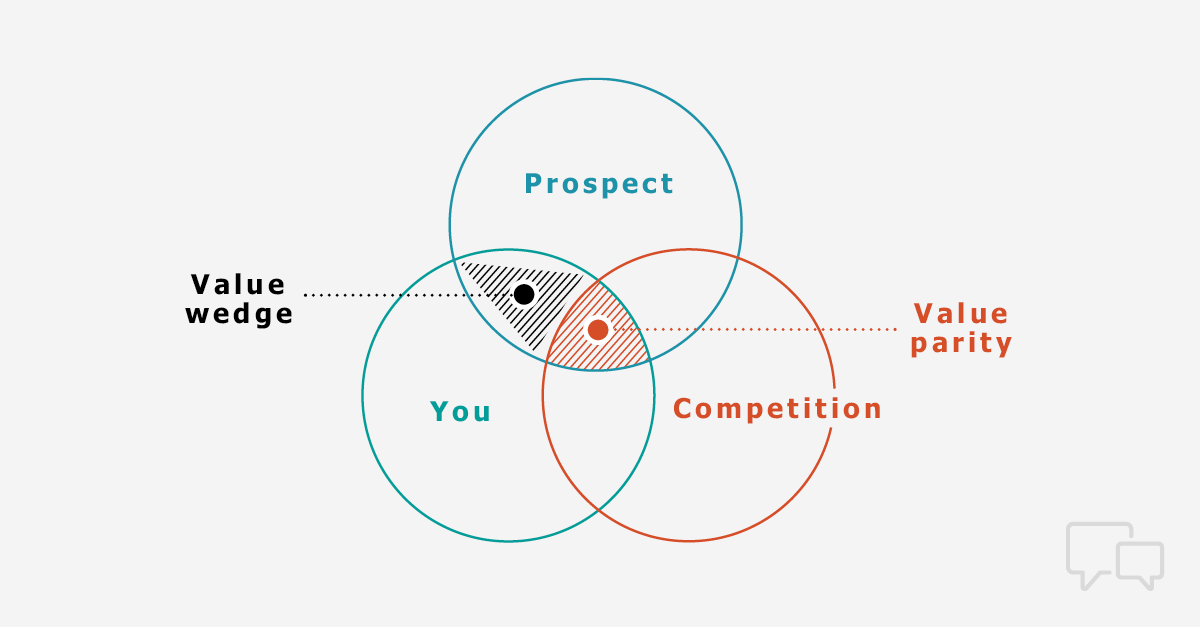
Your sales value proposition, or SVP, is a powerful messaging tool for communicating the unique value of the solution you’re selling. Unfortunately, most value propositions in sales fall short of delivering on that promise.
According to research by SiriusDecisions, only 10 percent of executives think sales calls provide enough value to warrant the time they spent on them.
A similar study by Forrester Research determined that only 15 percent of sales calls add enough value. That means 85-90 percent of sales calls are perceived as communicating no value—a staggering failure rate by any measure.
In short, most SVPs are poorly conceived and ineffectively delivered. So, what is a value proposition in sales? What are some common mistakes to avoid? And how can you build a truly unique value proposition of your own?
Common Value Proposition Mistakes
If your company is like most, you’ve carefully crafted your value proposition and you’ve trained your salespeople on how to use it. But considering the earlier statistics, the majority of SVPs fail to actually deliver any value to the customer.
Salespeople fail to articulate value when they commit the three deadly sins of sales messaging:
- Providing too much information
- Not describing value from the buyer’s perspective
- Failing to identify what’s different about them
A lot of SVP development advice reads like Mad Libs for business—a fill-in-the-blank formula or template that creates sales value proposition examples that look something like this:
[Product] is a [description] that [what it does] for [target audience] who need to [do something/solve a problem]. Unlike [alternative], it [differentiator].
But taking a formulaic approach will only create formulaic results.
Alternatively, some companies take a persona-based approach, where they bring definition to characters (personas) with names, demographic attributes, attitudes, and behaviors to help frame and target messages, including their value proposition for sales. But when used as a superficial profiling approach, personas can lead your messaging astray.
The result? Everyone follows the same approach, so everyone’s SVP sounds the same.
To stand out, you need to understand why your value proposition is coming up short. And that means changing the way you build and deliver it.
How to Build a Powerful Sales Value Proposition
There’s a better way to create a value proposition that actually communicates value and sets you apart from your competition. And it starts by finding your Value Wedge.

Most people build messages that unwittingly put them in the center of this Venn diagram. This area of Value Parity is the overlap between you and your competitors. Focusing here won’t communicate any real value for the customer—you just end up saying a lot of “me too” statements about your offerings that sound like everyone else.
Your best opportunity for differentiation is to focus on what you can do for the prospect that’s different from what the competition can do. This is your Value Wedge—this is where you find your distinct point of view.
To create a sales value proposition that sits in your Value Wedge, you need to:
1. Identify Previously Unconsidered Needs
Show your prospects a previously unconsidered, undervalued, or unmet need that’s relevant to them and puts their status quo in jeopardy. Revealing this inconsistency in their current model, in a way that’s different than what they’ve heard before, can motivate them to care about doing something different from what they’re doing today.
2. Attach the New Needs to Your Unique Strengths
Tell a compelling story that clearly shows the contrast between the gaps and deficiencies in the way your prospect is doing things today, and how those issues will be resolved with your new approach and unique strengths.
3. Defend Your Story
Arm yourself with proof points of times when comparable companies have identified the stated challenges, agreed to make the changes you recommend, and come out the other side with documented success. These proof points help defend your story as being different from your competitors and underscore the positive business impact you’re claiming.
When you create a value proposition that’s unique to you, important and relevant to your customer, and defensible, you have a powerful value proposition that actually communicates real value to your prospect.
In fact, the Value Wedge is designed to overcome all three of the deadly sales messaging sins mentioned earlier in this article. It helps you identify and focus on the unique strengths that only you can offer your buyer.
How to Deliver Your Value Proposition More Effectively
Once you have a well-crafted value proposition for your business development conversations, you’re still only halfway done. You need to understand how and—more importantly—when to deliver it.
Most salespeople lead with a sales pitch right away. But most prospects aren’t ready to hear it yet. Before you start talking about why they should choose you—your value proposition—you need to establish a Buying Vision that makes the case for why they need to change.
Why? Because your competitors aren’t the only thing standing in the way of your sale. Studies show that at least 60 percent of deals in the pipeline are lost to “no decision” rather than to competitors. Most customers you engage with are still trying to determine whether they really need to do anything different.
This means that despite what your buyers are telling you they want, you need to take a step back and make sure your prospect:
- Is convinced that they can no longer stick with their status quo
- Understands the needs and requirements they should be considering
- Appreciates the urgency of the situation, and
- Knows what capabilities and strengths they should be looking for
To make it happen, you need to grab the prospect’s attention, challenge their current assumptions, and persuade them to consider making a change. Only then—when your prospect cares enough to do something different—can you effectively introduce your value proposition and start leading them on a path to choosing you.
Want to improve how you develop and deliver your sales messages? With Corporate Visions sales training and messaging solutions, you can arm your sales reps with the research-backed selling techniques they need to effectively build pipeline and close more deals.





